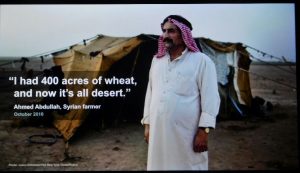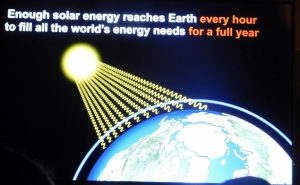
By Samuel Adeyanju
It was a beautiful Friday morning at the Bonn zone of COP 23.
My usual practice was to check the day’s schedule on the list of side events released by the UNFCCC secretariat prior to the COP event on my phone.
Fortunately, I decided to check one of the TV screens where I found this important event which was not on the list released by UNFCCC. Guess what! It was Al Gore coming to speak on climate change. Immediately, I made my way to the event hall.
Al Gore, Former US Vice President is a big name in the climate change world especially for his Climate Reality Project, a non-profit devoted to solving the climate crisis. This was confirmed by the huge number of participants ranging from journalists, youths and climate change enthusiasts that were already seated in the room for over an hour before the event commenced.
There was a lot of energy and expectations in the room as participants waited for the arrival of Mr. Al Gore. His arrival was announced by phone and camera flashes from every angle across the room as he approached the podium. I wasn’t left out since I have suddenly joined the league of photo journalists at COP. Haha
His speech provided a deep insight into various climate disasters across the globe as climate change impact is felt both in the global south and north. He ended his presentation highlighting the potentials of wind and solar energy as well as the numerous efforts being made by countries like Indian and others to implement the Paris Agreement by transiting to clean and renewable energy.
Below is a summary of the talk, hope you enjoy it.

The new normal in most ocean areas like Puerto Rico are devastating hurricane storms such as hurricane Harvey, Irma and Maria which cost the U.S up to $350 billion. Puerto Rico got 91cm of rain in 24hours leaving 83% of the people without access to electricity.
The Caribbean and Virgin Islands are not left out of these disastrous events as events that occur once every 500 years now occurs once every 25years example is Superstorm Sandy which occurred in the US. By 2030 to 2045, such storm is predicted to occur every 5 years. We have to change!
Just 2 weeks ago, Argentina was hit with 1.5 metres of hail in 15 minutes called hail bomb.
He stressed that more attention should be paid to Africa as the western cape declared 2 weeks ago that they had drought. As of November 2017, eight African and middle Eastern countries are approaching famine and 30 million people are nearing starvation. It is the first time in recent memory that so many large-scale hunger crises have occurred simultaneously.
This month, the United Nations issued warnings that the world is facing the worst humanitarian crisis since 1945. For instance, the 2006 -2010 drought turned 60% of Syria’s fertile land into desert and drove 1.5 million into Syria’s already crowded cities.
There has been Increase in temperatures and wildfires occurrences across the global. Early this year, 400 thousand hectares were burnt in Chile, same can be said of U.S, Canada and others. Just few years ago, Russia was hit by the worst fire and drought in its history, 55,000 people killed.
thousand hectares were burnt in Chile, same can be said of U.S, Canada and others. Just few years ago, Russia was hit by the worst fire and drought in its history, 55,000 people killed.
Four months after the fire, Russia took all of its grain off world market and food prices reached a record high for the second time in 3 years and there were food riots in 16 countries in South Asia and South America.
Not only are humans moving from unlive-able condition but also the average land base animal and plant species is moving at an average of 4.5 metres per day on our watch. We are in the danger of loosing up to half of all land base species in the century.
Air travel has a lot to do with the spread of tropical diseases to high latitudes for instance the zika epidemic last year the relationship between humans and microbes has always been mediated by climate and we are tilting the balance in favour of microbes and vectors that carry diseases.
Indian cities have the highest level of air pollutions in the world surpassing China with over 4000 schools closed due to air pollution in the past week. Glaciers melting with temperatures 26degrees higher than normal in Greenland and Antarctica leading to high tide and sea level rise.
We have to change because we are in the process of destroying human civilisation.
The World Economic Forum says the climate crisis is the number one treat to global economy. Japan and China are the number 1 and 2 subsidizers of building dirty coal burning plants in places like Indonesia, Vietnam and other developing countries. Although they are doing a lot better than the United States on so many metrics.
The good news is we have the solution at hand. Take for example, 17 years ago there was the most optimistic projection that the world will reach 30gigawatts of wind by 2010. However, we have exceeded that 16 times over.
Wind energy is now the cheapest form of electricity. Denmark is one of the leaders that reached more than 100 percent of their needs for 24 hours of one-day last year. US has enough wind energy to power more than 25 million homes. On a global scale, wind can supply 40 times as much energy as the entire global economy consumes.
 For solar energy, 15 years ago, the most optimistic projection for solar was 1 gigawatts per year of new capacity. Last year, that projection is exceeded 75 times over.
For solar energy, 15 years ago, the most optimistic projection for solar was 1 gigawatts per year of new capacity. Last year, that projection is exceeded 75 times over.
A number of countries are planning a fossil fuel vehicle phase out between 2025 and 2040 namely Norway, Netherlands, Indian, Scotland, France and Britain. Solar and wind contributes about 70% to the electric generation capacity of U.S. In the U.S, hundred leading multinational companies have pledged their to support to the Paris agreement regardless of U.S exit from the agreement.
In all, the consequences of climate change across the globe indicates why we have to change NOW!!!
Samuel Adeyanju from Nigeria, is an MSc student at the faculty of Forestry, University of British Columbia (UBC), Canada.











